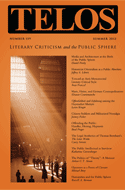Daniel Purdy’s “Media and Architecture at the Birth of the Public Sphere” appears in Telos 159 (Summer 2012). Read the full version online at the Telos Online website, or purchase a print copy of the issue here.
 This article examines the policy discussion surrounding the concept of “the European city.” This innocuous phrase has become a source of considerable concern among urban planners, architects, and sociologists because “the European city” is consistently described as under siege by the economics of globalization and new media technology. At stake is an idealized experience of urbanity that is closely associated with the history of European civilization, the emergence of liberal democracy, personal freedoms, and the market economy as a localized exchange that could be regulated by the state. Despite these modern connotations, the ideal type of this European city is medieval, wherein well-preserved historic buildings are aligned along irregular streets open only to pedestrians. The type of building that today is considered typical of the European city predates the Enlightenment and most certainly has little in common with industrialization.
This article examines the policy discussion surrounding the concept of “the European city.” This innocuous phrase has become a source of considerable concern among urban planners, architects, and sociologists because “the European city” is consistently described as under siege by the economics of globalization and new media technology. At stake is an idealized experience of urbanity that is closely associated with the history of European civilization, the emergence of liberal democracy, personal freedoms, and the market economy as a localized exchange that could be regulated by the state. Despite these modern connotations, the ideal type of this European city is medieval, wherein well-preserved historic buildings are aligned along irregular streets open only to pedestrians. The type of building that today is considered typical of the European city predates the Enlightenment and most certainly has little in common with industrialization.
The notion of the “European city” has a two-faced relation to globalization: on the one hand, the many economic, political and cultural relations that join cities together into the European market system constitute one of the large-scale networks of the global economy that historians can trace back to the height of the Middle Ages; on the other, the term is invoked today in order to draw a boundary and insist on a distinction so as to preserve a quality that is considered fundamentally European. This distinctly urban character is associated with public spaces that foster democratic institutions. Since the Middle Ages, the argument runs, European cities have been designed to preserve openly accessible forums for democratic politics and capitalist exchange. The preservation of European democracy is therefore often correlated with the maintenance of these urban places. I argue that the successful use of urban centers for politics and exchanges always also depends on the existence of small isolated spaces cut off from the general population. For urban public spaces to accomplish their political and economic ends, they have always required their antithesis, the exclusive private room. Nowhere is this juxtaposition more important than in the Enlightenment institution of the public sphere.







